
Concept explainers
Draw structures of the following derivatives.
- a. the 2,4-dinitrophenylhydrazone of benzaldehyde
- b. the semicarbazone of cyclobutanone
- c. cyclopropanone oxime
- d. the ethylene acetal of hexan-3-one
- e. acetaldehyde dimethyl acetal
- f. the methyl hemiacetal of formaldehyde
- g. the (E) isomer of the ethyl imine of propiophenone
- h. the hemiacetal form of 5-hydroxypentanal
(a)
Interpretation:
The structure of the given derivative is to be drawn.
Concept introduction:
Ketones and aldehydes show different types of reactions which results to form many different products. The nucleophilic addition reactions are the common reactions, which form products like imines, diols, alcohols, cyanohydrins, and alkenes.
Answer to Problem 18.37SP
The structure of the given derivative is shown in Figure 1.
Explanation of Solution
The given derivative is 2,4-dinitrophenylhydrazone of benzaldehyde.
The 2,4-dinitrophenylhydrazine is treated with benzaldehyde to form a 2,4-dinitrophenylhydrazone derivative.
The structure of 2,4-dinitrophenylhydrazone of benzaldehyde is given as,
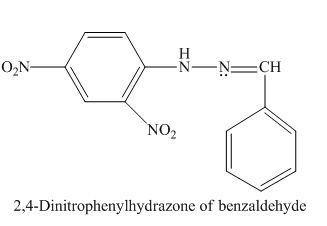
Figure 1
(b)
Interpretation:
The structure of the given derivative is to be drawn.
Concept introduction:
Ketones and aldehydes show different types of reactions which results to form many different products. The nucleophilic addition reactions are the common reactions, which form products like imines, diols, alcohols, cyanohydrins, and alkenes.
Answer to Problem 18.37SP
The structure of the given derivative is shown in Figure 2.
Explanation of Solution
The given derivative is semicarbazone of cyclobutanone.
The cyclobutanone is treated with semicarbazide to form a semicarbazone derivative.
The structure of semicarbazone of cyclobutanone is given as,
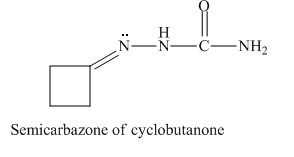
Figure 2
(c)
Interpretation:
The structure of the given derivative is to be drawn.
Concept introduction:
Ketones and aldehydes show different types of reactions which results to form many different products. The nucleophilic addition reactions are the common reactions, which form products like imines, diols, alcohols, cyanohydrins, and alkenes.
Answer to Problem 18.37SP
The structure of the given derivative is shown in Figure 3.
Explanation of Solution
The given derivative is cyclopropanone oxime.
The cyclopropanone is treated with hydroxylamine to form an oxime.
The structure of cyclopropanone oxime is given as,
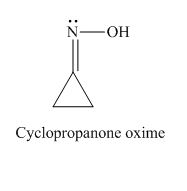
Figure 3
(d)
Interpretation:
The structure of the given derivative is to be drawn.
Concept introduction:
Ketones and aldehydes show different types of reactions which results to form many different products. The nucleophilic addition reactions are the common reactions, which form products like imines, diols, alcohols, cyanohydrins, and alkenes.
Answer to Problem 18.37SP
The structure of the given derivative is shown in Figure 4.
Explanation of Solution
The given derivative is ethylene acetal of hexan-3-one.
The ethylene glycol is treated with hexan-3-one to form ethylene acetal of hexan-3-one.
The structure of ethylene acetal of hexan-3-one is given as,
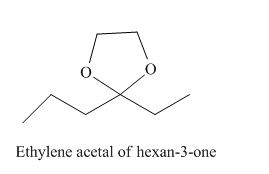
Figure 4
(e)
Interpretation:
The structure of the given derivative is to be drawn.
Concept introduction:
Ketones and aldehydes show different types of reactions which results to form many different products. The nucleophilic addition reactions are the common reactions, which form products like imines, diols, alcohols, cyanohydrins, and alkenes.
Answer to Problem 18.37SP
The structure of the given derivative is shown in Figure 5.
Explanation of Solution
The given derivative is acetaldehyde dimethyl acetal.
The acetaldehyde is treated with two moles of ethyl alcohol to form acetaldehyde dimethyl acetal.
The structure of acetaldehyde dimethyl acetal is given as,
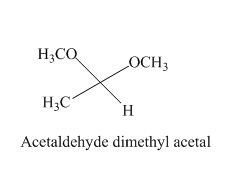
Figure 5
(f)
Interpretation:
The structure of the given derivative is to be drawn.
Concept introduction:
Ketones and aldehydes show different types of reactions which results to form many different products. The nucleophilic addition reactions are the common reactions, which form products like imines, diols, alcohols, cyanohydrins, and alkenes.
Answer to Problem 18.37SP
The structure of the given derivative is shown in Figure 6.
Explanation of Solution
The given derivative is methyl hemiacetal of formaldehyde.
The structure of hemiacetal of formaldehyde is given as,
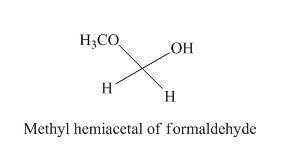
Figure 6
(g)
Interpretation:
The structure of the given derivative is to be drawn.
Concept introduction:
Ketones and aldehydes show different types of reactions which results to form many different products. The nucleophilic addition reactions are the common reactions, which form products like imines, diols, alcohols, cyanohydrins, and alkenes.
Answer to Problem 18.37SP
The structure of the given derivative is shown in Figure 7.
Explanation of Solution
The given derivative is (E)-isomer of the ethyl imine of propiophenone.
The propiophenone is treated with ethyl amine to form an ethyl imine derivative.
The structure of (E)-isomer of the ethyl imine of propiophenone is given as,
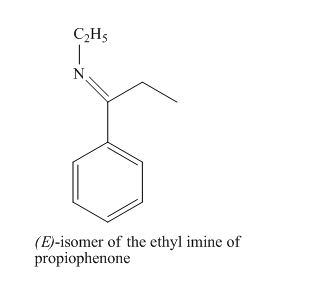
Figure 7
(h)
Interpretation:
The structure of the given derivative is to be drawn.
Concept introduction:
Ketones and aldehydes show different types of reactions which results to form many different products. The nucleophilic addition reactions are the common reactions, which form products like imines, diols, alcohols, cyanohydrins, and alkenes.
Answer to Problem 18.37SP
The structure of the given derivative is shown in Figure 8.
Explanation of Solution
The given derivative is hemiacetal of 5-hydroxypentanal.
The structure of hemiacetal of 5-hydroxypentanal is given as,
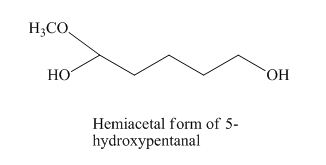
Figure 8
Want to see more full solutions like this?
Chapter 18 Solutions
ORGANIC CHEMISTRY MASTERINGCHEM ACCESS
- Briefly state the electrocapillary equation for ideally polarized electrodes.arrow_forwardWhat is surface excess according to the Gibbs model?arrow_forwardUsing Benzene as starting materid show how each of the Following molecules Contel Ve syntheswed CHI 9. b -50311 с CHY 503H Ночто d. อ •NOV e 11-0-650 NO2arrow_forward
- The molecule PYRIDINE, 6th electrons and is therefore aromatre and is Assigned the Following structure contering Since aromatk moleculoy undergo electrophilic anomatic substitution, Pyridine shodd undergo The Following reaction + HNO3 12504 a. write all of the possible Mononitration Products that could Result From this reaction 18. Bared upon the reaction mechanison determime which of these producty would be the major Product of the hegetionarrow_forwarda. Explain Why electron withdrawing groups tend to be meta-Directors. Your answer Should lyclude all apropriate. Resonance contributing Structures fo. Explain why -ll is an outho -tura drccton even though chlorine has a very High Electronegativityarrow_forward9. Write Me product as well as the reaction Mechanism For each of the Following Vanctions +H₂504 4.50+ T C. +212 Fellz 237 b. Praw the potential energy Diagrams For each OF Mese Rauctions and account For any differences that appear in the two potential Puergy Diagrams which of here two reactions 19 Found to be Reversable, Rationalice your answer based upon the venation mechanisms and the potential energy diagrams.arrow_forward
- 9. Write Me product as well as the reaction Mechanism For each of the Following Veritious +H2504 4.50+ + 1/₂ Felly ◎+ 7 b. Praw he potential energy Diagrams For each OF Mese Ronctions and account for any differences that appeak in the two potential Puergy Diagramsarrow_forwardDraw the major product of this reaction. Ignore inorganic byproducts. Incorrect, 3 attempts remaining 1. excess Br2, NaOH 2. neutralizing workup Qarrow_forwardGiven the electrode Pt | Ag | Ag+ (aq), describe it.arrow_forward
- At 25°C, the reaction Zn2+ + 2e ⇄ Zn has a normal equilibrium potential versus the saturated calomel electrode of -1.0048 V. Determine the normal equilibrium potential of Zn versus the hydrogen electrode.Data: The calomel electrode potential is E° = 0.2420 V versus the normal hydrogen electrode.arrow_forwardElectrochemistry. State the difference between E and E0.arrow_forwardIn an electrolytic cell, the positive pole is always assumed to be on the right side of the battery notation. Is that correct?arrow_forward

 Organic ChemistryChemistryISBN:9781305580350Author:William H. Brown, Brent L. Iverson, Eric Anslyn, Christopher S. FootePublisher:Cengage Learning
Organic ChemistryChemistryISBN:9781305580350Author:William H. Brown, Brent L. Iverson, Eric Anslyn, Christopher S. FootePublisher:Cengage Learning Chemistry & Chemical ReactivityChemistryISBN:9781337399074Author:John C. Kotz, Paul M. Treichel, John Townsend, David TreichelPublisher:Cengage Learning
Chemistry & Chemical ReactivityChemistryISBN:9781337399074Author:John C. Kotz, Paul M. Treichel, John Townsend, David TreichelPublisher:Cengage Learning


